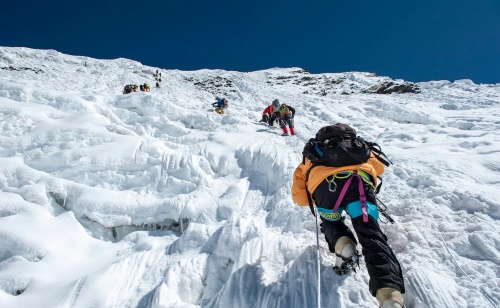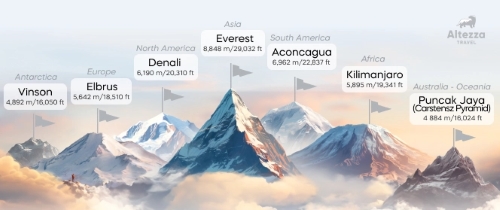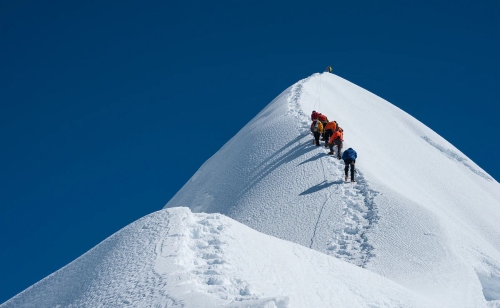Nepal has officially raised the climbing permit fees for Mount Everest by 36%, marking the first fee increase in nearly a decade. Effective from September 2025, climbers will face a significant hike in costs for the opportunity to conquer the world's tallest peak.
This move has sparked a wave of discussions about its impact on mountaineering tourism, environmental sustainability, and the overall future of Everest expeditions.
The new permit fees for climbing Mount Everest during the peak spring season will rise to $15,000 (approximately ₹12.35 lakh), up from the current $11,000(approx ₹9.48 lakh).
The Nepalese government has also announced new rates for other seasons, including autumn and winter, aiming to raise funds for environmental conservation and enhanced safety protocols.

Source: iStock
What is the new price hike by Nepal?
Here is the list of New Price hike by Nepal :
| Climbing Season | Previous Fee | New Fee (2025) | Increase | Indian Rupee Equivalent (approx.) |
| Spring | $11,000 | $15,000 | 36% | ₹12.35 lakh |
| Autumn | $5,000 | $7,500 | 50% | ₹6.17 lakh |
| Winter | $2,500 | $3,750 | 50% | ₹3.08 lakh |
Why is Nepal Raising Mount Everest Climbing Fees? Key Reasons Behind the Decision
Nepal’s decision to increase the climbing fees for Mount Everest is a strategic move aimed at addressing multiple challenges while benefiting the mountain, climbers, and local communities.
Here's a detailed breakdown of why the fee hike is essential for Everest's future.
1. Tackling Everest’s Environmental Crisis
- The additional funds raised from the fee hike will directly support clean-up programs aimed at removing waste and protecting the fragile environment of Everest.
- Nepal is committed to enforcing strict waste removal regulations so that climbers carry back all waste, contributing to the sustainability of Everest for future generations.
Why Does It Matters?
With the climbing fee increase, Nepal aims to ensure that Everest remains clean and pristine, helping to preserve its natural beauty and biodiversity while combating environmental degradation.
2. Enhancing Climber Safety & Reducing Overcrowding
- By raising the climbing permit fees, Nepal plans to limit the number of climbers on Everest, ensuring that only well-prepared, serious adventurers can afford the costly ascent.
- This will result in safer expeditions, reducing the risks associated with overcrowding and lack of preparation.
Why Does It Matters?
The climbing fee hike will make it easier to manage mountaineering traffic and ensure optimal safety conditions, creating a better experience for climbers while reducing accidents and fatalities.
3. Boosting Local Economy & Infrastructure Development
- The extra revenue generated from the higher climbing fees will be allocated to improving rescue operations, enhancing weather forecasting systems, and upgrading mountain climbing infrastructure. This will also provide economic support to the local communities that rely on tourism for their livelihoods.
Why Does It Matters?
By reinvesting in local development, this fee increase will create a more sustainable tourism model in Nepal, benefiting both climbers and local residents. It will also ensure the long-term growth of Nepal’s tourism industry, supporting future generations of adventurers and mountain communities.
The Bigger Picture: Why Nepal's Everest Fee Increase is Crucial for the Future?
- Nepal's decision to raise Mount Everest climbing fees is not just about increasing revenue; it’s a proactive step towards ensuring the environmental preservation, safety, and sustainability of one of the world's most iconic mountains.
- The funds generated will serve multiple purposes, from clean-up programs to local infrastructure development, directly benefiting the mountaineering community and local residents.
What is the Comparative Analysis of Climbing Fees for Everest and Other Major Peaks?
Nepal’s Everest climbing fees are among the highest globally.
Here’s how they compare to other renowned peaks:
| Mountain | Climbing Fee | Country | Notes |
| Mount Everest | $15,000 (Spring 2025) | Nepal | Fee hike aimed at sustainability, overcrowding. |
| K2 | $11,000 (Summer 2024) | Pakistan | One of the most difficult peaks to climb. |
| Mount Kilimanjaro | $1,500 - $2,500 | Tanzania | Lower costs but challenging trek. |
| Mount Denali | $11,000 | USA (Alaska) | Fees go toward maintenance and rescue teams. |
As we can see, Everest's climbing fees are among the most expensive, highlighting Nepal's effort to raise funds for environmental preservation and local economic growth. However, other mountains like K2 and Denali also command high fees due to their technical challenges and logistical support costs.

Source: altezzatravel
What is Nepal’s Strategy to Balancing Economy, Environment, and Safety?
- Sustainable Tourism: Nepal is prioritizing the long-term health of the Everest ecosystem. The funds raised will contribute to cleanup campaigns and green initiatives, with a focus on maintaining the beauty and sustainability of Everest for future generations.
- Infrastructure Improvements: The revenue will also be used to enhance safety measures, including better weather forecasting systems and rescue operations, addressing the growing demand for infrastructure improvement due to the increasing number of climbers.
- Revenue Generation for Local Communities: With an influx of climbers comes an increase in local business opportunities. Increased climbing fees are expected to generate more revenue for businesses that depend on mountaineering, such as trekking agencies, guides, porters, and hospitality services.
How the Fee Hike Affects the Climbers?’
Here is the reasons how climbers will feel after higher cost applied on hiking:
| Impact Area | Explanation |
| Higher Costs: What Climbers Need to Know? |
|
| Indian Climbers: Cost Impact & Shifting Trends |
|
| Sustainability Efforts: Fostering Responsible Tourism |
|
Source: iStock
Conclusion: The Future of Everest Expeditions
The fee hike for Mount Everest climbing permits represents a bold step toward protecting the environment, improving safety, and boosting Nepal’s economy.
As the global demand for climbing Everest continues, Nepal’s increased fees reflect its intention to ensure long-term sustainability of the region.
By implementing higher fees, the country is setting the stage for a future where the beauty and safety of Mount Everest are preserved, while also ensuring that local communities benefit from the influx of climbers.

Comments
All Comments (0)
Join the conversation